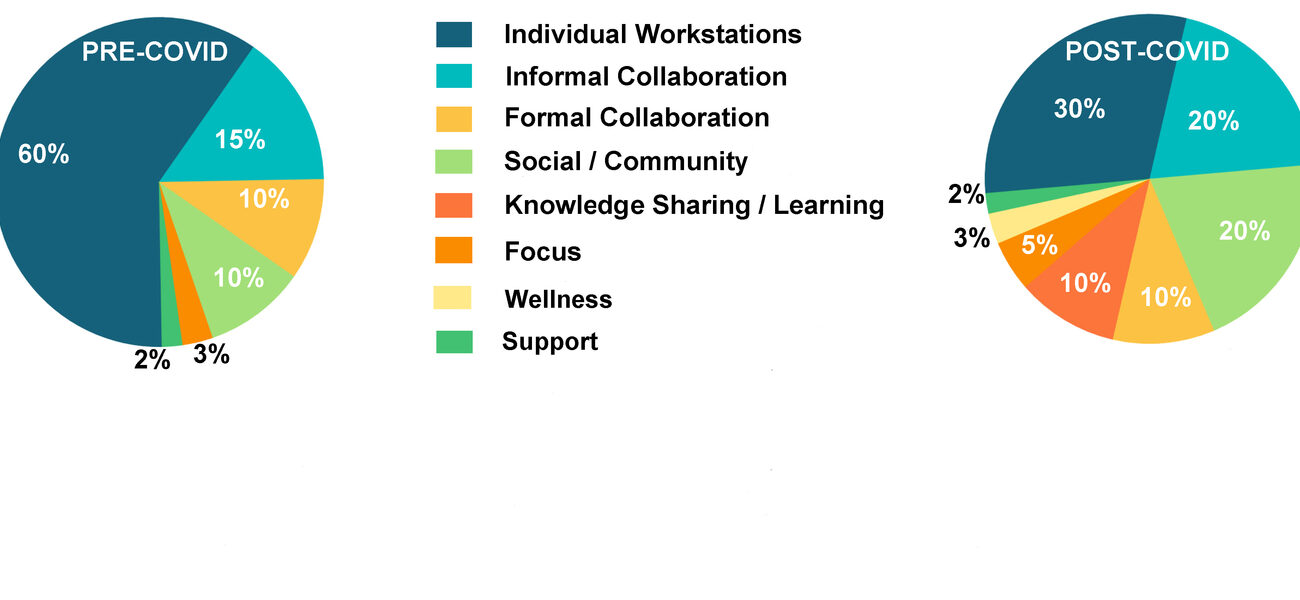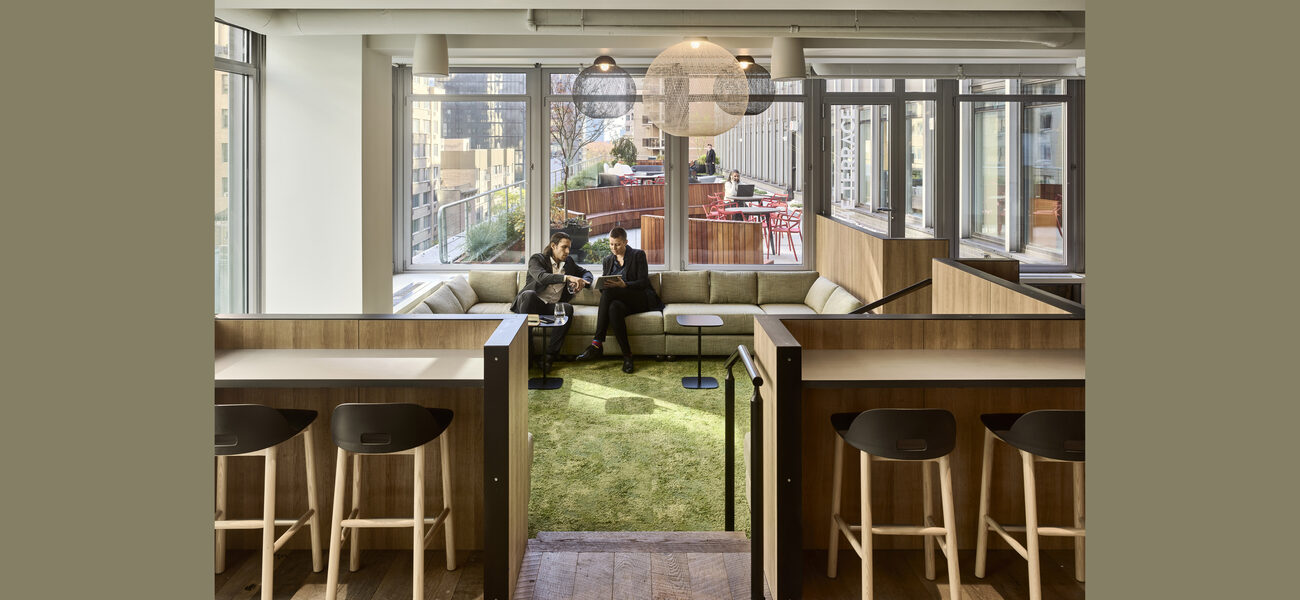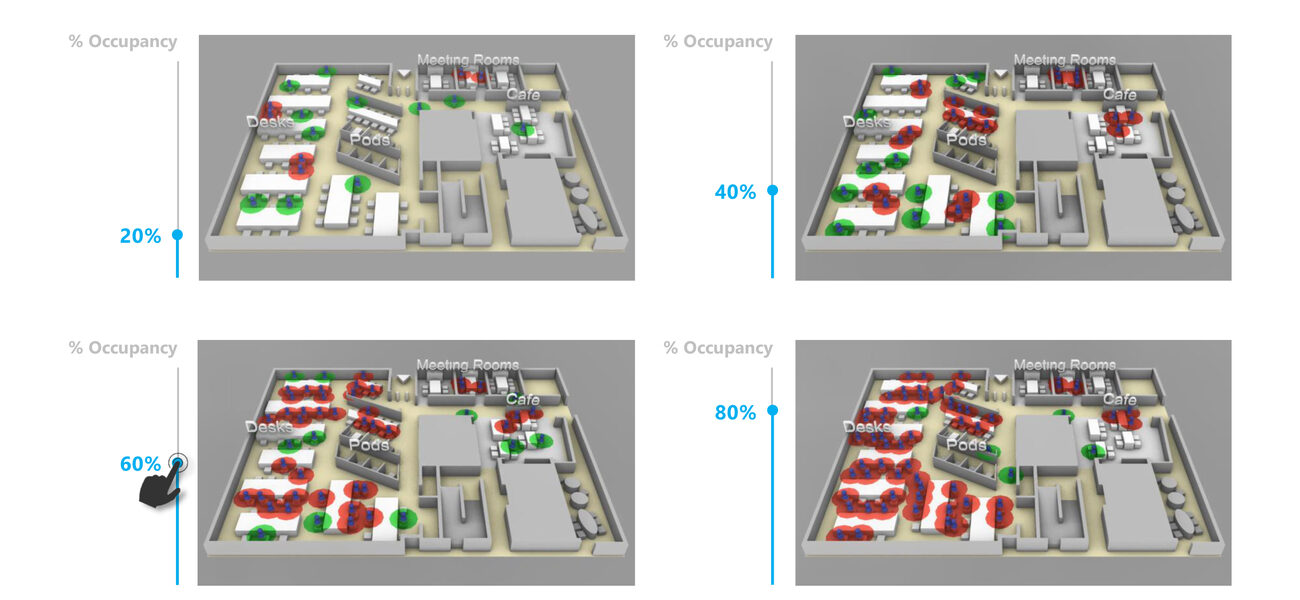Among all the questions about the post-COVID workplace, a common realization is taking hold: Organizations must be especially mindful of employee needs in their return-to-office planning. The pandemic upended not just the professional but also the personal side of workers’ lives. One of the things that distinguishes this new era is the much larger role empathy and understanding will play in the design process, says John Campbell, president of the architecture firm FCA. The new workplace will feature a variety of recalibrated space types that are more purposeful, employee driven, and less unitized.
“People are reevaluating their whole relationship with work, and as individuals, we all have different priorities that determine what that relationship is,” he observes.
“Nobody wants to go back to the office they left,” adds Ann Hoffman, FCA’s director of workplace strategies. “Two years of relative autonomy working from home has rewired employees to control their own environment. Leadership has to make it desirable for them to come back and play by the rules.”
“It is about attraction and retention,” echoes Elliot Felix, CEO of brightspot strategy, a Buro Happold company. It’s about creating magnetic places. Some people want to return, others have to be drawn there.”
Determining what features confer that magnetism or constitute those attractions doesn’t follow the standard design process. Today’s workforce populations are neurodiverse, and individuals want choices in their work environments.
A consensus is emerging that most organizations will wind up with a hybrid structure. That concept, however, covers a lot of ground.
“Everyone’s hybrid is different. Is it hybrid at the company level? At an individual level?” asks Campbell. “The word hybrid can mean multiple things. You have to define it for yourself and align it with the company’s values.”
The good news to extract from the past two years of massive disruption is that the opportunities to create new, more productive and satisfying work environments abound.
Surveys, Testing, and Trust
What does an organization need to know to design a successful hybrid workplace? Many of the steps and tools used in the pre-pandemic design process no longer apply.
“COVID has exploded all the old paradigms,” notes Campbell.
In particular, employee design preference surveys, which used to be based on a physical presence in the workplace, are now outdated. They have to be reinvented to address the new reality. Without observation studies to rely on, says Hoffman, “we have to start from scratch.”
“Employees don’t really know what they want, so the questions should be directed more to what they are doing, rather than at what they like,” adds Campbell, who recommends administering two different surveys several weeks apart.
“If you have more than 20 questions, people start to lose interest and the data are not useful,” he explains.
Another alteration to the traditional process is repeated prototyping and piloting. Innovations are by their nature unproven, and the lack of data to support their success could make it difficult to obtain high-level approval to move forward with something new. In these uncharted waters, testing is the only way to find out if a design or idea is suitable for a particular organization.
“The data can also be helpful to others,” says Campbell. “Right now we’re all in the same boat, so the more we can learn from each other about appropriate solutions for different settings, the better. The point is to prototype, pilot, observe, adjust, and keep going to make your workplace what you need it to be. Start collecting data right away on what is and is not working.”
The architects admit that the uncertainty generated by any number of workplace changes—be it design iterations or guidelines on in-office frequency—can be disconcerting to employees. Authenticity from leadership and bi-directional relationships of trust are key.
“No one knows the perfect answer to how to design your workplace,” says Campbell. “How we can best help, when people are stressed and anxious, is by providing clarity in the message. We need to be communicating a lot, authentically, even if it’s saying you don’t know all the answers.”
Day-in-the-Life
Having successfully done their jobs well from home with just a laptop, employees might now be wondering what the office is actually for. They need to become reacquainted with its benefits.
“People have had a singular view of their work life for two years, especially the newbies who’ve never had the office experience,” says Hoffman. “We really need to make people happy so that they want to come into the office and interact and benefit from the synergies that you will not get from the digital experience.”
Part of the answer is to get employees thinking beyond the confines of their own desk to envision the workplace in its entirety through a day-in-the-life exercise.
“This tool is extremely successful helping people to understand that their office is the whole office and not just one tiny component,” says Campbell. “It asks individuals what a day at work means for them. How do you understand the flexibility? How do you move through spaces and make use of them? How do you do the various aspects of collaboration?”
“We like to get people to think about their home,” adds Hoffman. “You don’t live in one room. You do different activities in different spaces and move through the spaces accordingly.”
Elliot Felix recommends a similar process. “Two very useful tools are personas and journey maps. Personas are archetypes of different users based on their motivations and their behaviors, not their demographics. A journey map is how they are using space and technology.”
As an illustration of the results of the day-in-a-life exercise, Campbell cites the gamut of space types his firm designed into the workplace for a forward-thinking client a few years ago: guest lounge, personal locker, reserved desk space, huddle room, phone room, community area with café and ping pong table, media connect room, personal booth, training room, and terrace.
“When you are building a destination, you need this level of mixed-use space,” he points out. “The time employees spend in the office is going to be even more valuable and spare, so you have to make it really impactful.”
Hoffman adds this caveat: “If we are going to condense our footprint through this exercise, it has to be the highest-value space that we can build.”
Equity
As they advance in their hybrid plans, organizations should be careful to avoid creating “two tiers of value for remote vs. onsite employees,” cautions Campbell. This is a particular pitfall of mixed online and in-person meetings, where remote participants are at a disadvantage because body language is less visible and transmission speeds disrupt the natural flow of conversation.
“Everyone being remote leveled the playing field a bit over the last year and a half,” observes Felix. Everyone’s picture is the same size on Zoom, but a hybrid version “has the potential to be much less equitable.”
Technology that enables each side to see each other and guidelines for equitable turn-taking are some solutions Felix recommends to keep remote attendees from feeling like second-class citizens. He also passes on a suggestion gleaned from a university student focus group: Extend the online connection to a hybrid class five minutes before and after the formal start and end time, giving physically dispersed participants the opportunity to gather and engage in informal conversation the same way they would in person.
FCA adopted a similar practice, allowing an extra 15 minutes online before and after meetings, so the physical and digital teams can first align their thoughts together and then debrief immediately after, when memories are fresh. “Those 15 minutes or so after a meeting are hugely important,” stresses Campbell.
The layout of the conference room also deserves a second look to promote the sense of equity in hybrid meetings. One possibility Campbell suggests is eliminating the head position at the conference table, instead turning it to face a wall of monitors where in-person and remote teammates have a broader view of each other. “We have to rethink how we position our environments,” he says.
More Tools and Tips
The empathy map, a tool typically deployed in product marketing, is another way to uncover employees’ thoughts and feelings about returning to the office, even those planning only a few visits per year. The FCA architects used this exercise to survey their own workforce. The initial statement, “When I return to the office…,” asked for responses in four categories: want, need, don’t want, and don’t need. The results revealed both the pain and the gain of coming into the office, giving the planners valuable information on why people are not returning. The answers are also useful to spark brainstorming sessions to create new capabilities, features, and amenities.
The architects caution that there are more complexities in managing a dispersed workforce. Despite the plethora of communication tools, the hybrid model requires more touchpoints to keep offsite employees engaged, especially those who are quiet and reserved. Campbell recommends a 15-minute bi-weekly check-in per employee, asking questions like how they’re doing, what’s coming up, and what they might need help with.
Mentoring and talent development programs may need to be more formal and intentional, advises Hoffman. Participants “need the experience of being around leaders,” she points out. “Post-COVID these goals could be met by scheduling that time, instead of allowing it to happen organically when you are in the same space.”
The architects have discovered that office acoustics are a huge issue for Zoom meetings, with voices echoing uncomfortably, even in a small quiet room. To date, acoustical treatments have tended to be less of a priority in office design, Hoffman observes, but that needs to change in the hybrid environment, for example by installing fabric-covered panels on the walls.
“If we are going to condense people in smaller spaces, noise and acoustics are numero uno,” she says.
With a different mix of occupants every day, the hybrid office will take on some of the characteristics of a co-working space, in particular temporary occupancy. Borrowing from the co-working model, organizations can benefit from a community manager, a concierge-like person with good communication skills who keeps track of all the comings and goings, is a liaison to building resources, and even attends to details like making sure used coffee cups aren’t left on a desktop.
In some respects, the new hybrid environment is accelerating trends that were already germinating pre-pandemic. Campbell cites a Steelcase prediction that the workstation portion of the overall office footprint will shrink to half. As space is redistributed, it will offer much more variety, with the incorporation of home-like features, including relaxed seating and kitchens that host cooking classes.
New policies for remote work should align with, not erode, the organization’s values, counsels Campbell. “With the right level of trust, more people will come in and spend more time together if you create the physical environment that enables them to do their best work.”
“You’ll know it’s right when people show up and stay the day to work,” adds Hoffman. “That means you’re doing everything you can to satisfy their needs and wants.”
By Nicole Zaro Stahl


